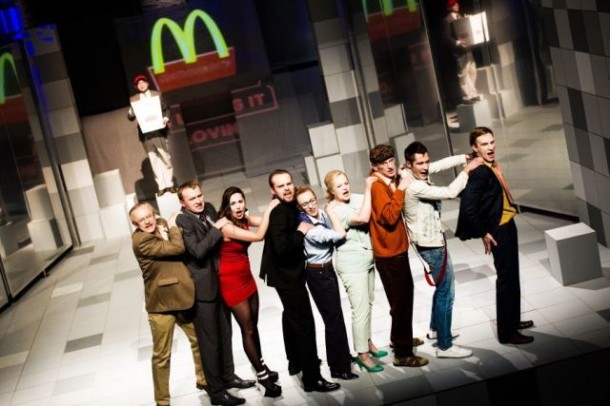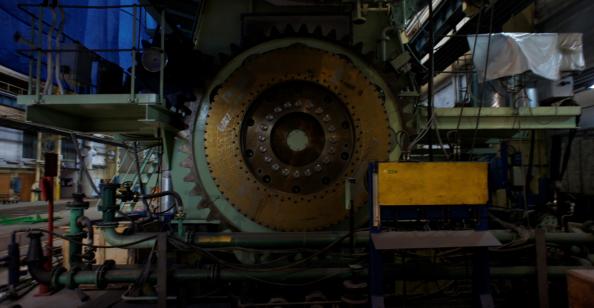In Poznan for a week in early October of 2013, I saw four productions that together give a sampling of the offerings in this theatrically active city. On my first night I attended the Teatr Polski, which was presenting Piszczyk, a highly popular new play (it premiered in May) by John Czapliński and Peter Rowicki. Jan Piszczyk, though perhaps unfamiliar to American readers, is a well-known folk figure in Poland, similar in many ways to the Czech Schweik. Like Schweik, Piszczyk is a clown-like little man caught in a rapidly shifting political world, but while Piszczyk shares Schweik’s blind enthusiasm, he is a failed, hapless opportunist, always a step behind the rapid changes, enthusiastically shouting the slogans and wearing the emblems of the previous regime just as the new one has made these unfashionable if not outright illegal.
Just as Brecht updated Schweik in his Schweik in the Second World War, Czapliński and Rowicki have moved Piszczyk from his early twentieth century world to a contemporary setting. Their version begins in 1989, in a free Poland, where Piszczyk, always in trouble with the regime, is released from prison on the day communism ends. Rather like Rip van Winkle, he is totally dazzled an confused by the new world into which he emerges. The striking setting by Matilda Zotlińska provides a perfect evocation of his condition. Piszczyk (beautifully portrayed by Luke Chrzuzcz) begins and ends the action standing, alone, confused upstage, while the converging side walls of the setting, composed of swiveling mirrors, are rapidly pushed around and around by the rest of the company, surrounding him with a dizzying whirl of reflected colors, perspectives, and bodies.
Piszczyk tries to plunge into this mad maelstrom of events, attempting to subscribe to the communist ideal and left behind when that vision collapses, striving to master capitalism, making and quickly losing a fortune on the stock market, never in sync in language, dress, or movement with the ten other members of the company, who, even though they have individual scenes with Piszczyk, more often appear as a chorus, moving in directions and in rhythms which he tries continuously and always in vain to imitate. Director Peter Ratajcyak never lets the actors or the sequence of images lag. The story covers the turbulent years of contemporary Poland, from 1989 to the present, which, seen through the eyes of Piszczyk becomes a tragicomic merry-go-round of rapid changes, and rarely for the better. Scene by scene and line by line it was clear the Polish audience found this whirlwind tour of their own lives profoundly funny and moving. Tumultuous applause followed the production.

Piszczyk by John Czaplinski and Peter Rowicki, directed by Peter Ratajcyak. Photo: courtesy of Teatr Polski, Poznan
One of the most impressive performance venues in Poznan is the Cultural Center in the “Castle” (Zamek), a landmark of the city, erected in a vaguely renaissance/medieval style by Kaiser Wilhelm II in 1913, the last imperial castle in Europe, and many times remodeled since, most notably by Albert Speer as a Polish residence for Hitler (which in fact he never occupied). After serving for a time as the City Hall, it is now a cultural center with a full program of dance, theatre, and spoken events. On 11 October I attended the premiere in the Center’s main theatre of a new dance piece, Whatever, by Tomasz Bazan. Bazan is a well-known choreographer in Poland, founder of his own company, Teatr Maat, and founder and director of the Maat Festival of international dance and movement. He has toured widely in Europe produced dance performances, happenings, and collective installations. I had not previously seen his work but was not highly impressed with this sample of it. Bazan was clearly concerned with challenging conventional expectations of dance audiences. For almost twenty minutes of the program, which lasted somewhat over an hour, no human body was seen. For about five minutes the audience was presented with an empty stage and offered rather stammering and confused bits of recorded sounds of people commenting on art. This sequence was followed by a long video of the sort seen on nature programs on television, which depicted a pride of lions stalking a herd of water buffalo, charging them and catching and attacking a young buffalo. After an extended sequence in which they killed and began eating their capture, the herd returned and chased the lions away.
Following this the dance proper began. First a musician occupied an area to the right, and began a series of sounds, some computer generated, some produced live by various percussive means, some generated on a keyboard, which provided the accompaniment for the action which followed. Four dancers, two men and two women, appeared in the nude, walked in a line across the stage, leisurely donned minimal rehearsal costumes and began to perform individual routines, often suggesting warm-up exercises. There was really no interaction, each performer remained essentially in their own area of the stage and although the women’s actions were rather more demanding than those of the men, who would from time to time assume statuesque poses or simply rock back and forth on their feet, all the dancers were soon glistening with sweat at the essentially non-stop and often extreme physical activity. After half an hour or so, it became clear that the major point of the exercise was a study in endurance, and although one of the men left the stage after nearly an hour, the others remained, clearly pushing themselves to the limit of their well-trained bodies.
Finally they left the stage and a live video showed them all nude again backstage, enjoying a well-deserved communal shower, while the accompanist continued to provide a sound background. Once they had showed and individually left the filmed area, the stage remained empty for another five minutes or so during which the sound track which opened the evening was resumed. Although the physical exertions and the endurance of the dancers was impressive, this minimalist evening really offered little else, and I strongly sympathized with the spectators who left in a small but steady stream through most of the last half of the production.
I was much more satisfied with my experience the following evening, attending the most recent show of one of the best known experimental companies in Poland, and indeed in Europe, the Theatre of the Eighth Day (Teatr Ósmego Dnia). Ever since its founding in the 1960s the company has been concerned with developing non-traditional, non-linear performances and with contemporary social issues. This often brought them into conflict with Soviet censors and not infrequently with the much more tolerant governments that have followed, although the state subsidy they receive has been several times threatened, and may well have been curtailed had it not been for their considerable continuing popular support.
The new production by the company is entitled Cegloz, a significant name in modern Polish theatre, since it was at the machine factory of this name in Poznan where occurred in June of 1956 the first in the Polish workers’ demonstrations against the Soviet government, brutally crushed by the military and the police. In the actual space of this factory, now empty and abandoned, Theatre of the Eighth Day presented a memorial to the Cegloz workers, the text of which was composed almost entirely of material from interviews of former workers at the factory, in most cases not involving their experience of the strike but their personal stories, their dramas, their beliefs, and their views of their work.
, Sidney E. Cohn Professor of Theatre at the City University of New York Graduate Center, is the author of many articles on theatrical theory and European theatre history, and dramatic literature. He is the 1994 recipient of the George Jean Nathan Award for dramatic criticism and the 1999 recipient of the American Society for Theatre Research Distinguished Scholar Award. His book The Haunted Stage: The Theatre as Memory Machine, which came out from University of Michigan Press in 2001, received the Callaway Prize. In 2005 he received an honorary doctorate from the University of Athens. His most recent book is The Theatres of Morocco, Algeria and Tunisia with Khalid Amine (Palgrave, 2012).



